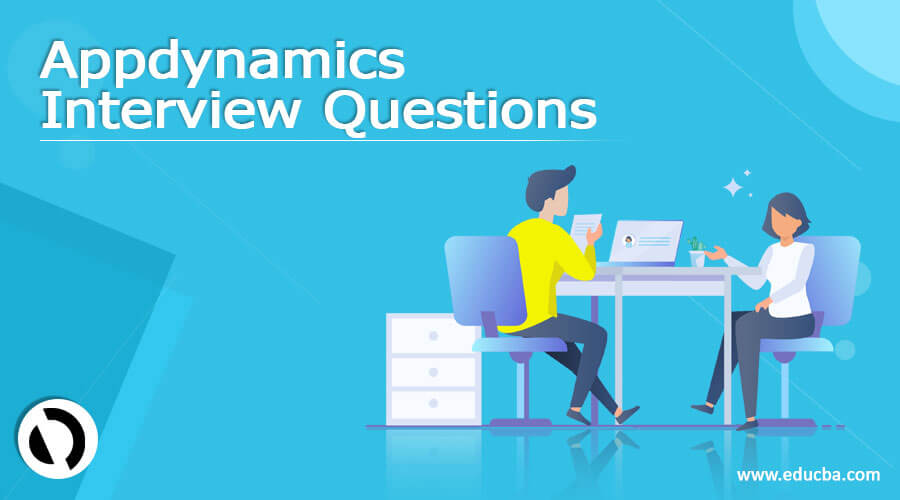Updated April 18, 2023

Introduction to Appdynamics Interview Questions
Appdynamics Interview questions will include the most important topics that cover the whole interview process on Appdynamics. It is designed to manage the operations and performance of available applications. Appdynamics is a tool used for application performance management and operation analytics based out in San Francisco. Its focus is mainly on the availability of applications across the cloud computing environments. Here, we shall see some of the top 25 questions that will help improve one’s knowledge and also help to clear any interviews based on Appdynamics.
Appdynamics Interview Questions
Let us discuss Appdynamics Interview Questions.
Q1. Define Appdynamics
Ans. Appdynamics is a tool that helps to serve monitoring purposes and manage the performance of tools in a given environment.
Q2. List out different types of Agents in Appdynamics
Ans. AppAgent, Machine Agent, Browser Agent, and Database Agent.
Q3. Differentiate Grid Layout and Absolute Layout
Ans. Grid Layout, user cannot overlap one widget over the other whereas, in Absolute Layout, users can overlap one widget over the other.
Q4. What is Widget?
Ans. Widget is small reports in form of charts or dashlets available, showcasing available data, i.e., easy to understand.
For e.g., Application Load time vs Response time.
Q5. What are all the different Flow Map available?
Ans. There are 3 Flow Maps available, i.e., Node Flow Map, Application Flow Map and Business Transaction Flow Map.
Node Flow Map is used for load balancing in one application and is used to check each individual nodes behaviour, load and error rate, and response time.
Application Flow Map is used to create an overall application dashboard.
Business Transaction Flow Map is used for checking particular Business Transaction dashboards.
Q6. List out different kind of reports
Ans. There are two types of reports, scheduled reports by default and the other being On-Demand Reports.
Scheduled Reports: Here, users can create reports based on Cron job script to create, set, and daily or weekly based reports. Details can be scheduled to execute on a daily/ weekly/ monthly basis based on the user requirement.
On-Demand Reports: There are a total of 7 On-Demand Reports that are available for use,
1. Business Transaction Summary Report
2. Hardware Utilization Report
3. Business Transaction Trend Report
4. Memory Utilization Report
5. Node Trend Report
6. Node Performance Summary Report
7. Custom Report
Q7. Based on triggers in Appdynamics, what are all the actions or policies that can take place?
Ans. There are some of the action policies that take place in Appdynamics based on triggers,
- Diagnostics are collecting details while the user is away.
- Notifications are sent via Email or SMS
- Remediations i.e., the script for performing an action for any triggered problem
- Custom actions can also be taken
- HTTP Request, user can send 3rd party request using HTTP calls
- Autoscaling, which helps in increasing or decreasing the count of servers in production
Q8. What are the ways of Authentication in Appdynamics?
Ans. LDAP is used for Corporates and Application, SAML login is used to integrate with Microsoft, Facebook, Yahoo, Google, etc. and Local Appdynamics Authentication is used to share links to view dashboards or HTML-based dashboards.
Q9. What is Beacon?
Ans. Beacon collects data from the web browser’s page request that is opened via browser after page load event gets completed and send it to EUM service. The controller downloads this data and displays it on the application browser.
Q10. How is the Database monitoring setup in Appdynamics?
Ans. Database agent in Appdynamics connects via JDBC to monitored databases. Agent sends data to the controller that uses Event Service to store a particular type of data and the app agent provides information regarding calls to backend databases inclusive of errors and call counts. Database module exhibits visibility to working of the database server itself providing information about query execution and agentless profile performance.
Q11. Why is Appdynamics tool used for Application performance?
Ans. Appdynamics offers a global view across the application landscape and allows quickly navigating through distributed applications into graphs or exception reports. At tier level, Appdynamics provides runtime operation view via Appdynamics App Server Agent.
Q12. How Infrastructure Monitoring or Servers work in Appdynamics tool?
Ans. In Appdynamics, there is a preconfigured application infrastructure metrics and by default health rules for enabling users to discover infrastructure problem. Users can also configure additional metrics to implement monitoring strategies specific to the business needs and the architecture of the application. Server Visibility in Appdynamics contributes to the data center by value addition on the performance of machines and networks in the user’s environment.
Q13. List out the important checks in EUM
Ans. Network time taken to travel between the End-user and the server i.e., Server connection time, Load time, i.e., time taken by the server to respond to a client call, and the browser time i.e., DOM ready time.
Q14. What is Triple Nine Availability?
Ans. It is the term used to say Appdynamics is providing the utmost availability of the application.
Q15. Define Synthetic Monitoring
Ans. It is mimicking the real user for the different locations with a different browser to test if in case they are getting the expected response.
Conclusion
With this, we shall conclude the topic “Appdynamics Interview questions”. We have seen all are the important questions for Appdynamics and listed out them here so that each topic might get covered and be interview ready. As of here, we have listed our top 15 questions in such a way that people preparing for the Appdynamics interview can easily clear it off. Thanks! Happy Learning!!
Recommended Articles
This is a guide to Appdynamics Interview Questions Here we discuss the Introduction, Appdynamics Interview Questions respectively. You may also have a look at the following articles to learn more –
